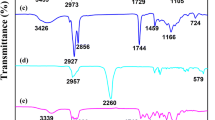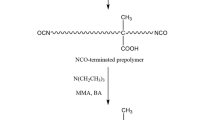Abstract
Stable emulsions of crosslinkable waterborne polyurethanes (CWPU) and waterborne polyurethane-acrylic (CWPU/AC) hybrid with various contents of trifunctional monomer (trimethylolpropane, TMP) and acrylic monomers were successfully prepared in this study. This study focused on the effects of crosslinkable TMP and acrylic monomer contents on the stability/average particle size/viscosity of CWPU and CWPU/AC hybrid emulsions, the mechanical/dynamic mechanical thermal properties, surface contact angle/tension and hardness/water swelling of CWPU and CWPU/AC hybrid film materials. The as-polymerized CWPU emulsion containing 0.06 mol (4.11 mol%) of TMP and CWPU/AC hybrid emulsion containing 60 wt% of acrylic monomer were found to be unstable, indicating that these contents were beyond the limit value of the self-emulsifying ability of dimethylol propionic acid (18.26 mol%). By XPS analysis, CWPU and CWPU/AC film samples were found to have silicone/fluorine enriched surface. The tensile strength/modulus/hardness of the film samples increased markedly with increasing crosslinkable TMP/acrylic monomer up to 0.04 mol/50 wt%, respectively. Meanwhile the elongation at break and water swelling % decreased significantly. The water/ethylene glycol contact angles increased/the surface tension decreased significantly with increasing crosslinkable TMP/acrylic monomer contents up to 0.04 mol/50 wt%. Thus, the optimum TMP/acrylic monomer contents were found to be about 0.04 mol/50 wt% to obtain high performance antifouling coating materials.







Similar content being viewed by others
References
Lu YS, Richard CL (2007) New hybrid latexes from a soybean oil-based waterborne polyurethane and acrylics via emulsion polymerization. Biomacromolecules 8:3108–3114
Modesti M, Lorenzetti A (2001) An experimental method for evaluating isocyanate conversion and trimer formation in polyisocyanate–polyurethane foams. Eur Polym J 37:949–954
Lee SY, Lee JS, Kim BK (1997) Preparation and properties of water-borne polyurethanes. Polym Int 42:67–76
Rahman MM, Kim HD (2006) Synthesis and characterization of waterborne polyurethane adhesives containing different amount of ionic groups (I). J Appl Polym Sci 102:5684–5691
Shin MS, Lee YH, Rahman M, Kim HD (2013) Synthesis and properties of waterborne fluorinated polyurethane-acrylate using a solvent−/emulsifier-free method. Polymer 54:4873–4882
Kim BG, Sohn EH, Cho K, Lee JC (2008) Semifluorinated side group poly(oxyethylene) derivatives having extremely low surface energy: synthesis, characterization, and surface properties. Eur Polym J 44:2912–2919
Zhao Z, Li X, Li P, Wang C, Luo Q (2014) Study on properties of waterborne fluorinated polyurethane/acrylate hybrid emulsion and films. J Polym Res 21:460–468
Xiao X, Wang Y (2009) Emulsion copolymerization of fluorinated acrylate in the presence of a polymerizable emulsifier, colloids. Surf A Physicochem Eng Asp 348:151–156
Hirose M, Kadowaki F, Zhou J (1997) The structure and properties of core-shell type acrylic-polyurethane hybrid aqueous emulsions. Prog Org Coat 31:157–169
Lee SW, Lee YH, Park H, Kim HD (2013) Effect of total acrylic/fluorinated acrylic monomer contents on the properties of waterborne polyurethane/acrylic hybrid emulsions. Macromol Res 21:709–718
Park YG, Lee YH, Rahman MM, Park CC, Kim HD (2015) Preparation and properties of waterborne polyurethane/self-cross-linkable fluorinated acrylic copolymer hybrid emulsions using a solvent/emulsifier-free method. Colloid Polym Sci 293:1369–1382
Wang L, Shen Y, Lai X, Li Z, Liu M (2011) Synthesis and properties of crosslinked waterborne polyurethane. J Polym Res 18:469–476
Lai X, Shen Y, Wang L (2011) Preparation and properties of self-crosslinkable polyurethane/silane hybrid emulsion. J Polym Res 18:2425–2433
Yue S, Zhang Z, Xiao C (2015) Effect of 3-aminopropyltriethoxysilane on solvent resistance, thermal and mechanical properties of two-component waterborne polyurethane. Int J Polym Anal Ch 20:285–297
Lopez A, Degrandi-Contraires E, Canetta E, Creton C, Keddie JL, Asua JM (2011) Waterborne Polyurethane − Acrylic hybrid nanoparticles by Miniemulsion polymerization: applications in pressure-sensitive adhesives. Langmuir 27:3878–3888
Mequanint K, Sanderson R (2003) Self-assembling metal coatings from phosphated and siloxane-modified polyurethane dispersions: an analysis of the coating–air interface. J Appl Polym Sci 8:893–899
Lee JR, Jin FL, Park SJ, Park JM (2004) Study of new fluorine-containing epoxy resin for low dielectric constant. Surf Coat Technol 180:650–654
Cui X, Zhong S, Wang H (2007) Synthesis and characterization of emulsifier-free core–shell fluorine-containing polyacrylate latex. Colloids Surf A Physicochem Eng Asp 303:173–178
Saidi S, Guittard F, Guimon C, Géribaldi S (2006) Synthesis and characterization of copolymers based on styrene and partially fluorinated acrylates. Eur Polym J 42:702–710
Rahman MM, Lee I, Chun HH, Kim HD, Park H (2014) Properties of waterborne polyurethane-fluorinated marine coatings: the effect of different types of diisocyanates and tetrafluorobutanediol chain extender content. J Appl Polym Sci 131:39905
Kong X, Liu G, Curtis JM (2011) Characterization of canola oil based polyurethane wood adhesives. Int J Adhes Adhes 31:559–564
Chattopadhyay DK, Webster DC (2009) Thermal stability and flame retardancy of polyurethanes. Prog Polym Sci 34:1068–1133
Rahman MM, Kim HD, Lee WK (2009) Properties of waterborne polyurethane adhesives: effect of chain extender and polyol content. J Adhes Sci Technol 23:177–193
Levine F, Scala JL, Kosik W (2010) Properties of clear polyurethane films modified with a fluoropolymer emulsion. Prog Org Coat 69:63–72
Kaelble D, Moacanin J (1977) A surface energy analysis of bioadhesion. Polymer 18:475–482
Acknowledgments
This work was supported by the National Research Foundation of Korea (NRF) grant funded by the Korea government (MSIP) through GCRC-SOP (No. 2011-0030013).
Author information
Authors and Affiliations
Corresponding author
Rights and permissions
About this article
Cite this article
HyeLin, K., YoungHee, L., JungSoo, K. et al. Preparation and properties of crosslinkable waterborne polyurethane and polyurethane-acrylic hybrid emulsions and their crosslinked polymers. J Polym Res 23, 240 (2016). https://doi.org/10.1007/s10965-016-1134-y
Received:
Accepted:
Published:
DOI: https://doi.org/10.1007/s10965-016-1134-y




